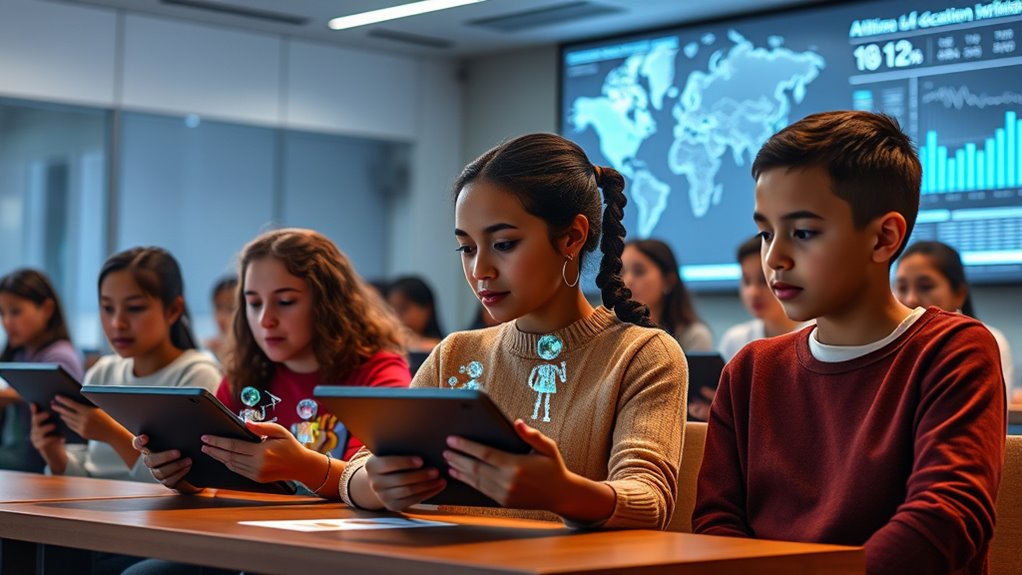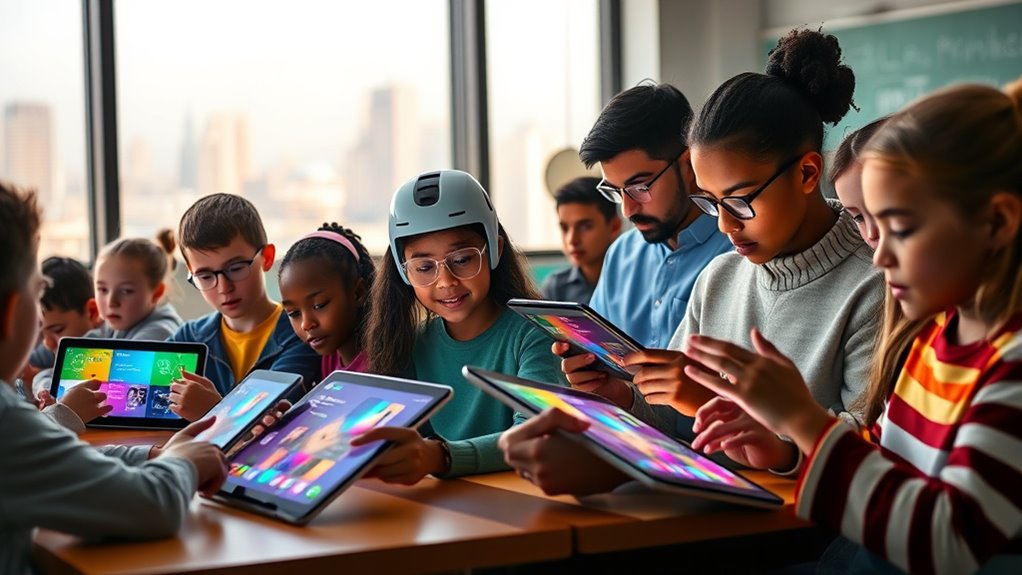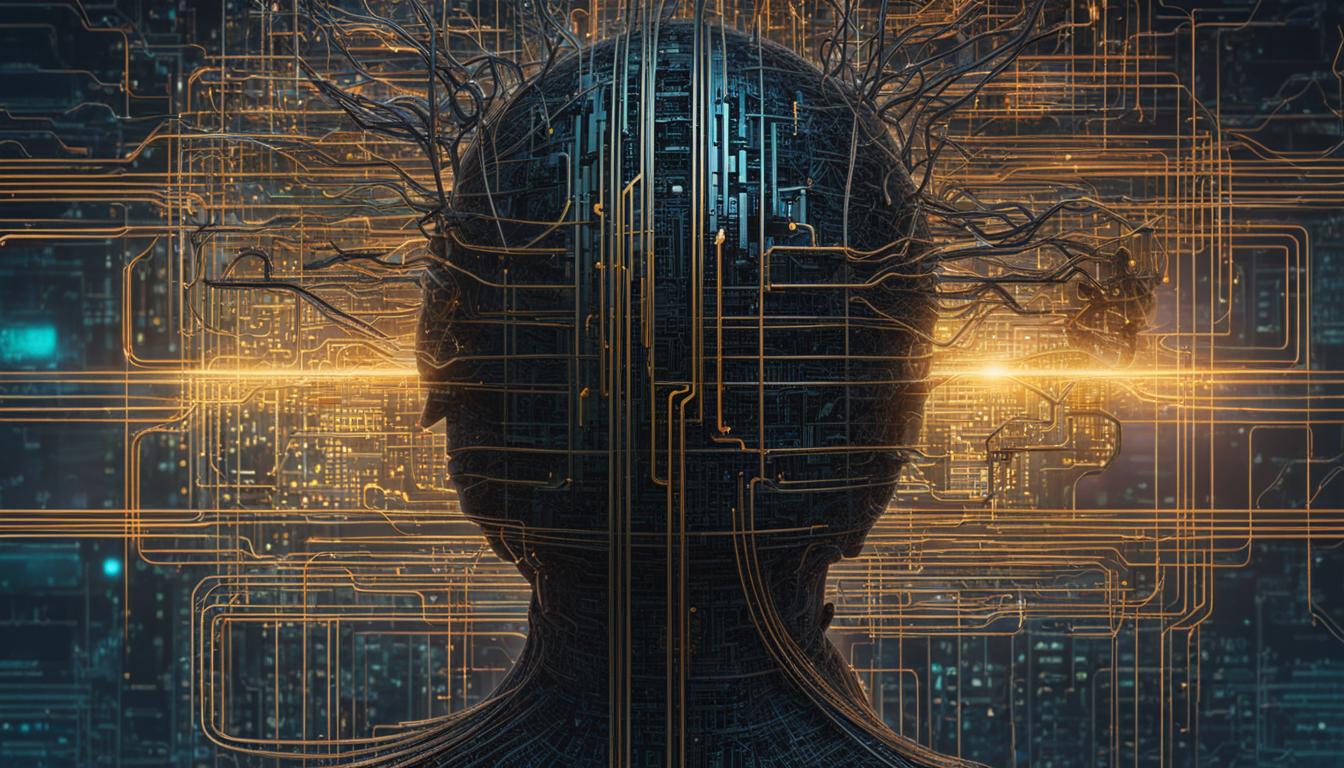AI tutors are revolutionizing education by offering personalized learning experiences tailored to each student’s needs. They adapt content, pace, and feedback to boost motivation, improve test scores, and support at-risk learners. These tools make education more engaging and equitable, reaching students in remote and underserved areas. As AI continues to expand globally, understanding how these solutions work can help you see their full potential. If you keep exploring, you’ll discover more about this transformative shift.
Key Takeaways
- AI tutors deliver personalized learning experiences tailored to individual student needs and preferences.
- Advanced AI systems analyze real-time data to adapt content, pacing, and difficulty levels for each learner.
- Scalable AI tools expand access to quality education across diverse geographic and socioeconomic communities.
- Integration of natural language processing enhances interactive, engaging, and intuitive tutoring interactions.
- AI-driven platforms support early intervention, tracking progress, and providing targeted feedback for improved outcomes.
The Rapid Expansion of AI in Education Markets

The expansion of AI in education markets is happening at an unprecedented pace, driven by advancements in technology and increasing demand for personalized learning solutions. You’ll notice the market’s value soared to USD 6.5 billion in 2024 and is projected to hit USD 208.2 billion by 2034, with a compound annual growth rate of 41.4%. This rapid growth is fueled by easier access to AI tools and platforms, making them available across online learning platforms and mobile apps worldwide. As a result, more schools and institutions are adopting AI-driven systems to enhance teaching and learning. This trend is transforming education, creating new opportunities for personalized, scalable, and accessible learning experiences for students everywhere. Additionally, the integration of Natural Language Processing (NLP) has significantly improved customer experience in educational platforms by enabling more personalized and engaging interactions. The advancements in AI technology continue to drive innovation, making educational tools more intuitive and effective. Moreover, the increasing availability of environmentally sustainable solutions in technology development supports responsible growth in the sector. Furthermore, insights from Honda Tuning can inspire the development of tailored AI tutoring systems for specific student needs, enhancing the overall learning experience. Recent developments in AI hardware are also contributing to faster and more efficient processing, further propelling the market forward.
Enhancing Student Motivation and Engagement Through Personalization

Personalized learning powered by AI markedly boosts student motivation and engagement by tailoring educational experiences to individual interests and needs. When you use AI-driven platforms, you can explore topics that truly excite you and learn at your own pace, which builds confidence and autonomy. These systems adapt content based on your progress, making lessons more relevant and less frustrating. As a result, you’re more likely to participate actively and attend classes regularly—studies show a 12% increase in attendance in AI-enhanced environments. The interactive, personalized approach keeps you motivated, reduces boredom, and encourages curiosity. By focusing on your unique strengths and interests, AI personalization makes learning more enjoyable and meaningful, inspiring you to stay engaged and committed to your educational journey. Incorporating Pimple Patches into skincare routines demonstrates how targeted, customized solutions can lead to more effective results and greater satisfaction. Additionally, the integration of Intelligent Tutoring Systems is paving the way for scalable, personalized education that adapts to each learner’s specific needs. Recognizing the importance of adaptive learning, educators are increasingly leveraging AI to create dynamic learning environments that respond to individual progress and challenges. Furthermore, understanding educational data allows AI to refine its personalization strategies, ensuring continuous improvement in student outcomes.
Boosting Academic Performance With Ai-Driven Platforms

AI-driven platforms can profoundly boost your academic performance by providing customized learning paths tailored to your strengths and needs. They use data-driven insights to identify areas for improvement and track your progress over time. As a result, you’ll see enhanced test scores and a clearer understanding of your academic journey. Additionally, leveraging personality assessments can help tailor educational approaches to individual learning styles, further enhancing engagement and effectiveness. Incorporating nutrient-rich content in learning modules can also support cognitive function and memory retention, optimizing the educational experience. Recognizing the influence of astrological compatibility can sometimes offer insights into students’ interpersonal dynamics and learning preferences, fostering a more personalized educational environment. Moreover, integrating creative storytelling techniques can make learning more memorable and emotionally engaging for students.
Enhanced Test Scores
Have you ever wondered how technology can transform student performance? AI-driven platforms make it possible by personalizing learning experiences to meet individual needs. These systems adapt content in real-time, focusing on areas where you’re struggling and reinforcing strengths. As a result, your understanding deepens, and test scores improve considerably. Schools using AI report a 75% increase in student performance, with many students achieving 70% better course completion rates. AI also provides targeted feedback, helping you identify and correct mistakes quickly. This tailored approach keeps you engaged and motivated, leading to higher retention of knowledge. By addressing gaps early and offering continuous support, AI platforms help you perform better on exams and build confidence in your academic abilities. Additionally, predictive modeling enhances the system’s ability to forecast your learning needs and optimize instructional strategies. Incorporating personalized learning strategies ensures that each student receives the appropriate level of challenge and support, further boosting educational outcomes. Moreover, adaptive content customization allows for a more efficient learning process, catering to diverse learning styles and paces. Implementing learner analytics can provide valuable insights into individual progress and help educators tailor interventions more effectively. The integration of self-reflection techniques encourages students to assess their progress and set future goals, further enhancing their development.
Custom Learning Paths
Because every student learns differently, custom learning paths tailored by AI platforms adapt content and pacing to fit your individual needs. These platforms analyze your strengths, weaknesses, and interests to create a personalized curriculum that evolves as you progress. Instead of a one-size-fits-all approach, you receive targeted lessons, exercises, and resources that align with your learning style. This flexibility allows you to spend more time on challenging topics and quickly move through areas you’ve mastered. By continuously adjusting the difficulty and focus, AI-driven paths keep you engaged and motivated. Additionally, adaptive learning technology ensures that the content remains relevant and appropriately challenging throughout your educational journey. Leveraging AI content clusters enhances the organization of related lessons, making it easier to build upon previous knowledge for better retention. Incorporating personalized feedback further refines the learning process, helping you identify areas for improvement. Regular security assessments can also help ensure that your learning data remains protected from potential cybersecurity threats. Integrating diverse design options from innovative educational tools can also make learning more engaging and visually appealing. As a result, you can learn more efficiently, improve retention, and achieve better academic outcomes. Custom learning paths truly empower you to take control of your education, making learning more relevant and effective.
Data-Driven Insights
Data-driven insights are transforming how educators understand student performance and tailor instruction. By analyzing real-time data, AI platforms reveal patterns in learning behaviors, engagement, and gaps. This allows you to identify struggling students early, customize interventions, and optimize teaching strategies. The table below highlights key aspects of AI-driven insights:
| Benefit | Impact |
|---|---|
| Personalized feedback | Targets individual needs for better outcomes |
| Early warning systems | Prevents dropout through timely support |
| Engagement analytics | Boosts motivation and participation |
| Performance tracking | Measures progress and adjusts goals |
| Learning style analysis | Adapts content to diverse learner preferences |
These insights enable you to make data-informed decisions that elevate student success efficiently. Additionally, leveraging anime movies in educational contexts can foster engagement and cultural understanding among students. Moreover, understanding relationship dynamics can help educators build stronger connections with students, creating a more supportive learning environment.
AI for Early Intervention and Reducing Dropout Rates

AI-powered early warning systems are transforming how schools identify students at risk of dropping out. These systems analyze data like grades, attendance, participation, and engagement to spot warning signs early. By flagging at-risk students, you can intervene before issues escalate, offering targeted support tailored to each student’s needs. This proactive approach helps prevent discouragement and disengagement, increasing the likelihood students stay on track. Additionally, AI tools provide flexibility for students who miss classes, enabling meaningful participation remotely. Early intervention not only boosts retention rates but also fosters a more supportive learning environment. With real-time insights, you can act swiftly, ensuring students receive the help they need when they need it most—saving more students from dropping out and improving overall educational outcomes.
Promoting Self-Directed Learning and Reading Habits

Building on the success of early intervention systems that keep students engaged, AI tools also foster self-directed learning and stronger reading habits. With personalized recommendations, you’re encouraged to explore topics that interest you at your own pace, boosting confidence and autonomy. AI platforms track your progress, providing real-time feedback and tailored goals that motivate you to stay committed. Daily learning durations increase, and your reading volume grows, especially when AI suggests books aligned with your interests. These platforms make it easier to develop consistent habits by offering engaging content and interactive features. As a result, you become more proactive in your education, building skills that translate beyond the classroom. AI empowers you to take charge of your learning journey, leading to better academic outcomes and lifelong habits.
Overcoming Challenges in AI Literacy Among Students and Educators

You need to focus on building AI skills for both students and educators to overcome literacy gaps. Enhancing educational equity requires targeted efforts to guarantee everyone can effectively use AI tools. Addressing these challenges is essential for making AI-supported learning accessible and impactful for all.
Building AI Skills
Despite the growing integration of AI in education, many students and educators face significant hurdles in developing essential AI literacy skills. You might picture students struggling to understand AI concepts, teachers feeling unprepared, and learning environments lacking proper resources. To build AI skills, focus on:
- Providing engaging, hands-on training sessions that demystify AI fundamentals
- Creating accessible online courses tailored for different skill levels
- Incorporating real-world AI applications into curricula to boost relevance
- Offering ongoing support and mentorship to reinforce learning
- Promoting collaboration among students and teachers to share insights and solutions
These strategies help bridge knowledge gaps, foster confidence, and guarantee everyone can participate meaningfully in AI-driven education. Overcoming these challenges is crucial for preparing students and educators for a future shaped by AI technology.
Enhancing Educational Equity
As AI becomes more integrated into education, addressing disparities in AI literacy is essential for ensuring equitable learning opportunities. Many students and teachers feel unprepared to leverage AI tools effectively, risking widened gaps. To bridge this divide, targeted training and resources are crucial. Here’s a snapshot of current challenges:
| Group | Confidence Level | Key Barriers |
|---|---|---|
| Students | 42% feel confident in AI use | Lack of exposure, skills gaps |
| Teachers | 17% report advanced literacy | Limited professional development |
| First-generation students | Less confident in AI use | Socioeconomic barriers |
| Schools | Insufficient AI training programs | Funding constraints |
Overcoming these challenges empowers everyone to access personalized learning and promotes true educational equity.
Addressing Equity Gaps in AI-Enabled Learning Environments

Addressing equity gaps in AI-enabled learning environments requires targeted strategies to guarantee all students benefit from technological advancements. You need to make certain marginalized groups aren’t left behind. Think about:
- Providing targeted training for teachers to support diverse learners.
- Developing culturally responsive AI content that reflects students’ backgrounds.
- Ensuring device and internet access for underserved communities.
- Designing AI systems that recognize and adapt to different learning styles.
- Collecting and analyzing data to identify and close persistent gaps.
The Impact of AI Tutors on Classroom Dynamics

AI tutors are transforming classroom dynamics by providing personalized support that complements traditional teaching methods. They adapt to each student’s pace, allowing learners to explore topics deeply without feeling rushed or left behind. As a result, you notice increased student engagement and participation, since learners feel more confident and motivated. AI systems also help teachers identify struggles in real-time, enabling targeted interventions that improve overall classroom flow. With AI handling routine or individualized tasks, you find more opportunities for meaningful interactions and group activities. This shift fosters a more dynamic, inclusive environment where students feel valued and supported. Ultimately, AI tutors reshape the classroom into a space that balances personalized learning with collaborative growth, enhancing the educational experience for everyone involved.
Future Trends: Scaling Personalized Learning Globally

The rapid expansion of AI-powered personalized learning tools is paving the way for their global scaling, making education more accessible across diverse regions. You’ll see AI break down barriers by reaching remote and underserved communities, offering tailored support regardless of location. Imagine:
- Students in rural areas accessing high-quality tutors via mobile devices.
- Multilingual AI systems bridging language gaps effortlessly.
- Local educators collaborating with AI to adapt curricula culturally.
- Low-cost AI platforms providing affordable education solutions.
- Data-driven insights guiding policy and resource allocation worldwide.
This growth will foster equity, enabling learners everywhere to pursue personalized pathways. As AI integration deepens, you’ll witness a revolution where education becomes more inclusive, adaptive, and responsive to individual needs on a global scale.
Building a Supportive Ecosystem for AI in Education

To effectively integrate AI in education, you need to focus on strengthening infrastructure and ensuring all students can access these tools. Teacher training programs are essential to help educators confidently implement AI solutions and support student success. Additionally, developing equity and inclusion strategies guarantees that every student benefits from AI advancements, regardless of background.
Infrastructure and Accessibility
Building a robust support system for AI in education requires investing in infrastructure that guarantees reliable access and seamless integration across diverse learning environments. You need scalable internet connections, secure data servers, user-friendly platforms, and interoperable systems that connect devices and tools effortlessly. Imagine:
- Broadband networks reaching rural and underserved areas
- Cloud-based platforms ensuring smooth data flow
- Compatible devices like tablets, laptops, and smartphones
- Secure authentication systems protecting student information
- Multi-language interfaces catering to diverse learners
These elements create an inclusive ecosystem where AI tools work reliably, reach all students, and foster equity. Ensuring such infrastructure supports continuous access, minimizes disruptions, and promotes widespread adoption, making personalized learning accessible to everyone.
Teacher Training Programs
How can educators effectively integrate AI into their teaching practices if they lack proper training? The answer is robust teacher training programs designed to build AI literacy and practical skills. These programs should focus on familiarizing you with AI tools, understanding their capabilities, and learning how to incorporate them seamlessly into lesson plans. Hands-on workshops, online courses, and peer collaboration foster confidence and competence. Ongoing professional development is essential, keeping you updated on evolving AI technologies and best practices. Schools must prioritize creating ecosystems that support continuous learning, encouraging experimentation without fear of failure. When you’re well-trained, you can confidently leverage AI to personalize instruction, boost student engagement, and improve outcomes, ultimately transforming your teaching approach and enhancing student success.
Equity and Inclusion Strategies
Integrating AI into education offers tremendous potential to enhance learning for all students, but without targeted strategies, it can also deepen existing inequalities. You must build a supportive ecosystem that promotes equity and inclusion. Consider:
- Providing accessible AI tools for students with disabilities
- Offering ongoing AI literacy training for teachers and students
- Designing culturally responsive AI content that reflects diverse backgrounds
- Ensuring affordability and equitable distribution of AI resources
- Engaging communities to address unique local needs and barriers
Frequently Asked Questions
How Can AI Tutors Adapt to Diverse Learning Styles and Cultural Backgrounds?
AI tutors adapt to your diverse learning styles and cultural backgrounds by customizing content and teaching methods tailored to your preferences. They analyze your interactions, identify what works best for you, and adjust accordingly. By incorporating culturally relevant materials and varying instructional approaches, AI tutors guarantee you stay engaged and motivated. This personalized approach helps you learn more effectively, respecting your unique background and individual needs.
What Measures Ensure Data Privacy and Security in Ai-Powered Classrooms?
You should implement strict data privacy policies, including encryption and anonymization, to safeguard student information. Regular security audits and access controls limit data exposure, while transparent consent processes ensure students and parents understand data use. Educate staff and students on privacy best practices, and comply with legal standards like GDPR or FERPA. These measures build trust, prevent breaches, and keep student data safe in AI-powered classrooms.
How Can Educators Effectively Integrate AI Tools Without Replacing Human Interaction?
You can’t just sprinkle AI tools into your lessons and hope for magic; you need to actively blend technology with genuine human connection. Engage students through meaningful conversations, personalized feedback, and empathetic support that AI can’t replicate. Use AI as a powerful assistant, not a replacement, to enhance interactions. Prioritize relationships, foster collaboration, and let your presence guide the learning journey—making technology an extension of your human touch.
What Strategies Are Available to Improve AI Literacy Among Students and Teachers?
To improve AI literacy among students and teachers, you can implement targeted training programs and workshops that focus on practical AI skills and ethical considerations. Encourage hands-on experiences with AI tools, integrate AI topics into curricula, and foster collaborative learning environments. Providing ongoing support and resources helps build confidence, ensuring both students and teachers develop the necessary understanding to effectively utilize AI in education.
How Do AI Tutors Address Challenges Faced by First-Generation and Underserved Students?
Imagine an underserved student using an AI tutor that adapts lessons to their unique needs, helping them catch up and build confidence. AI tutors address challenges by providing personalized support, bridging gaps in access, and offering culturally relevant content. They foster engagement and motivation, especially for first-generation students, by creating a tailored learning experience that promotes equity and helps overcome barriers to success.
Conclusion
As AI tutors become more accessible, you can personalize learning, boost motivation, and improve performance. You’ll see early interventions reduce dropout rates, foster self-directed habits, and bridge equity gaps. You’ll experience classroom dynamics transforming, global scaling expanding opportunities, and a supportive ecosystem growing. Embrace these changes, harness the power of AI, and unleash your potential through personalized learning that adapts, engages, and elevates every student, every time.










